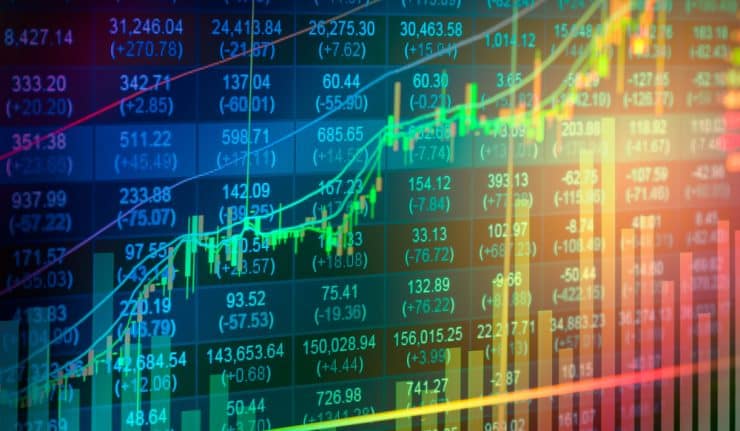
April is usually a good month for stocks, but there are plenty of reasons why it could be cruel this year.
As markets leave behind the volatile months of February and March, worries that helped drive stocks lower continue to hang over April. Trade tensions are unresolved, and tech weakness remains a concern as does uncertainty around White House personnel and the Russia investigation. The Fed is steady on its course to raise interest rates two or more times this year.
The big event in the coming week is the March employment report on Friday. Economists expect about 200,000 jobs and a pickup in wages of 0.3 percent. The employment rate could slip a notch to 4 percent.
But traders were already taking what sounds like good news and spinning it into the next big fear — rising inflation that could fuel more Fed rate hikes.
“Everybody’s homing in on the payroll data. The rumors are that it’s going to be a really big number,” said Art Cashin, director of floor operations at UBS. “What [traders] want to see is if it’s a really big number, will it put pressure on the wages?”
April, on average, is the second-best month for the S&P 500, going back to World War II, but the problem for this April is that it comes during a midterm election year. In those years, the second quarter is often weak for stocks, as is the third.
“April is actually the second-best month of the year, and it has risen 69 percent of the time,” said Samuel Stovall, chief investment strategist at CFRA. “The average price gain is 1.4 percent, versus 0.67 percent for all months.”
But it could face other headwinds this year.
“While normally the second quarter is a positive quarter for the market, up 1.8 percent since World War II, it’s down an average 2.2 percent during midterm election years, and it doesn’t get much better in the third quarter,” Stovall said. He said the weakness comes amid concerns that the party in power could lose its majority.
“Like the old saying, the best house on a bad block. It could be the best month in a bad quarter,” he said.
For March, the S&P 500 lost 2.7 percent, and it was down 1.2 percent for the quarter. The Nasdaq, hit hard in March by tech weakness, lost 2.9 percent but it was still positive for the quarter, up 2.3 percent.
Traders have been watching the 200-day moving average, which is a key technical support level for the index, at 2,589 Thursday. Watched as an indicator of price trends, the 200-day is simply an average of the closing value of the last 200 trading days.
The S&P bounced from that level in February and again last Monday. But it’s an area that traders continue to watch for a possible retest.
“Equity markets have been experiencing extreme moves both up and down all week, but the near-term trend that’s in place is pointed downward instead of upward,” Bespoke said in a note.
“Thus far, the S&P 500 has managed to hold support above its 200-day moving average, but the more the 200-day gets tested, the more likely it is to ultimately break.”
Stovall said another worry that’s been nagging at the market is the ever-narrowing difference in yields between longer- and shorter-duration Treasurys. That distance between the yield on the 2-year and the 10-year Treasury has been flattening, to just 47 basis points Thursday, the lowest since October 2007.
The concern is that a ‘flat’ curve is leading to an inverted curve, where the 2-year, at 2.26 percent, would rise above the 10-year, now at 2.73 percent. That would be a warning of a coming recession, but for now many strategists do not believe it is yet signaling a downturn.
Credit concerns have been circling the markets, as traders watch the ticking up of Libor rates. The London interbank offered rate is the rate at which banks lend to each other.
Analysts say changes in U.S. tax law have changed the way corporations treat short-term securities, and that and a high volume of U.S. Treasury securities has created a market imbalance, forcing Libor to rise. In itself, it is not considered an issue, since it is seen as technical, but traditionally the rate has been watched as an indicator for financial stress.
Spreads have risen in other markets, and the focus in the past week was on the high yieldmarket, where Tesla’s debt downgrade sent its yield spiking. Analysts said Tesla did not affect other names.
Oleg Melentyev, head of U.S. high-yield credit strategy at Bank of America Merrill Lynch, said he sees high yield holding up well relative to other asset classes. “However, stability is not immune to how long volatility episodes last, and in a scenario where, let’s say, equities were down 10 percent from here, I cannot imagine an outcome where HY does not take a real hit,” he wrote in an email.
“Aside from that, issuer fundamentals are actually in decent shape, and we think this cycle has more to go before it turns, which at the end of the day is what matters the most to this asset class,” he added. “A tail risk I am watching here is what is going on in some large IG [investment grade] capital structures, like GE, where bonds are now trading at 105 bps spreads, up from 40 just a few months ago. It’s still a single-A rated issuer, and it has 30 bps to go before it trades like an average BBB.”
